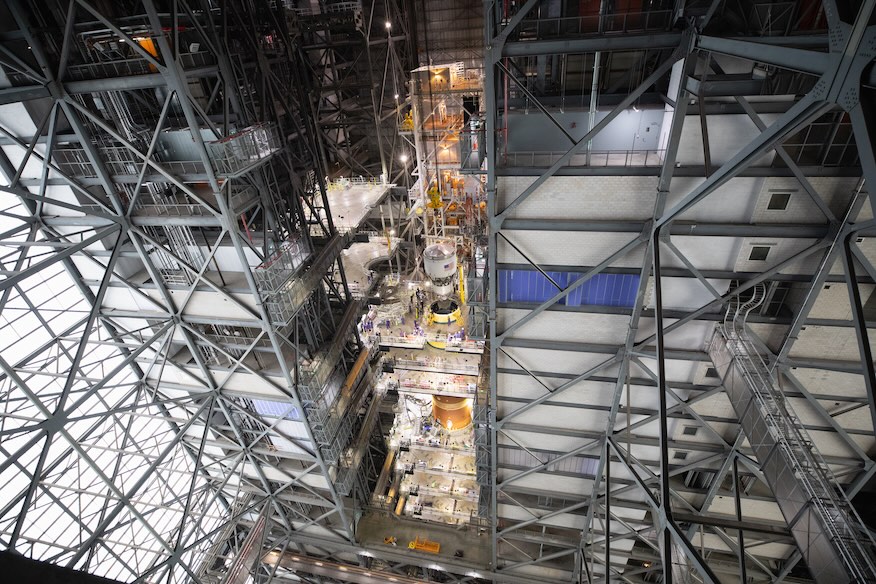Proposed 24 percent cut to NASA budget eliminates key Artemis architecture, climate research
The White House released its proposed federal spending budget for Fiscal Year 2026 on Friday and with it a series of deep cuts to most areas of discretionary spending, including to NASA. The requested cuts come, ironically, on National Space Day.
If adopted as proposed, America’s space agency is facing a 24.3 percent funding cut, dropping it from about $24.8 billion in FY25 to $18.8 billion in FY26. The agency was hoping for a funding increase to get a number of programs back on track following two years of what amounted to spending cuts due to budgets being held at FY24 spending levels.
That loss in spending will be felt most deeply by the space and Earth science divisions, which would see a loss of $2.3 and $1.2 billion respectively. Conversely, Human Space Exploration would be allocated “over $7 billion for lunar exploration and introducing $1 billion in new investments for Mars-focused programs,” which the White House believes will ensure “that America’s human space exploration efforts remain unparalleled, innovative, and efficient.”
“This proposal includes investments to simultaneously pursue exploration of the Moon and Mars while still prioritizing critical science and technology research,” said acting NASA Administrator Janet Petro in a statement. “I appreciate the President’s continued support for NASA’s mission and look forward to working closely with the administration and Congress to ensure we continue making progress toward achieving the impossible.”

On the chopping block for President Donald Trump is the Mars Sample Return mission, which the White House said is “grossly over budget and whose goals would be achieved by human missions to Mars.”
The Trump Administration also aims to “eliminate funding for low-priority climate monitoring satellites” months after NASA scientists determined that 2024 was the warmest year on record, increasing about 2.65 degrees Fahrenheit (1.47 degrees Celsius) compared to the mid-19th century average.
“Once again, the temperature record has been shattered — 2024 was the hottest year since record keeping began in 1880,” said then NASA Administrator Bill Nelson back in January. “Between record breaking temperatures and wildfires currently threatening our centers and workforce in California, it has never been more important to understand our changing planet.”
In an April 30 letter sent to the leaders of the Senate and House committees that oversee NASA’s budget, several organizations, including the American Astronomical Society, the Coalition for Deep Space Exploration and The Planetary Society, expressed their “profound alarm” at the proposal that was being reported at the time.
“The impact extends far beyond mission hardware. These cuts would eviscerate space science research and analysis programs, crippling university departments, research institutions, and NASA centers,” the letter stated. “It would decimate the nation’s STEM talent pipeline, eliminating vital training opportunities for the next generation of scientists and engineers and likely lead to widespread layoffs within this highly skilled workforce, both in the government and industry.”
Shifting Moon priorities
Also facing the budgetary ax is the Artemis Program. The proposed budget suggests “allocating over $7 billion for lunar exploration and introducing $1 billion in new investments for Mars-focused programs,” while simultaneously calling for an early end to the Space Launch System rocket and Orion spacecraft, along with cancelling the Moon-orbiting Gateway mini-space station.
“The Budget phases out the grossly expensive and delayed Space Launch System (SLS) rocket and Orion capsule after three flights. SLS alone costs $4 billion per launch and is 140 percent over budget,” the White House said. “The Budget funds a program to replace SLS and Orion flights to the Moon with more cost-effective commercial systems that would support more ambitious subsequent lunar missions.”
Spaceflight Now reached out to both Boeing and Lockheed Martin, the prime contractors behind the SLS rocket and Orion spacecraft respectively. We’re waiting to hear back.

If NASA were to lose funding for SLS and Orion beyond Artemis 3, the agency would no longer need the larger SLS Block 1B rocket, which would use the 390-foot-tall Mobile Launcher 2 (ML-2) currently under construction at Kennedy Space Center.
Construction crews recently added the seventh of ten planned umbilical tower modules to the structure’s launch platform. , the prime contractor for ML-2, didn’t reply to a request for comment by publication.
“The budget would transition NASA to a more sustainable, cost-effective approach to lunar exploration by retiring the SLS (Space Launch System) rocket, Orion spacecraft, and supporting ground systems after Artemis III, and ending the Gateway program – opening the door to next-generation commercial systems and expanded international collaboration,” said NASA Press Secretary Bethany Stevens in a statement when asked about the fate of the ML-2 work, if the proposed budget were adopted.
The Trump Administration also seeks to do away with the Gateway, a lunar space station with international involvement from Canada, Europe, Japan and the United Arab Emirates. The first Gatway module was received by Northrop Grumman in Gilbert, Arizona and is set to be launched in 2027 on a SpaceX Falcon Heavy rocket.

Stevens told Spaceflight Now that the agency has “informed our international partners impacted by this budget proposal” about things like the cancellation of Gateway, but said that “Those conversations will remain private as discussions are ongoing.”
The loss of Gateway would also mean changes for the agency’s Human Landing System (HLS) program, which is managed at NASA’s Marshall Space Flight Center in Huntsville, Alabama. Blue Origin’s Blue Ghost Mk. 2 lander was planned to dock with Gateway to receive astronauts before heading down to the Moon’s surface on the Artemis 5 mission.
The HLS version SpaceX’s Starship rocket will dock directly with the Orion spacecraft during Artemis 3 and is planned to dock with the Gateway during Artemis 4.
During a so-called “tag up” meeting at MSFC on Friday, Lisa Watson-Morgan, the HLS program manager, said that because of the commercial style of their program, they likely wouldn’t face much change in the work they’re doing, but acknowledged that this is still very early in the process and that more information would come in future all-hands meetings.
Audio of the meeting was shared by online publication, NASAWatch.com, which is not officially affiliated with NASA. The meeting audio was divided into two clips (Part 1 and Part 2).
“Change like this can be very, very hard. It can be very hard, even if we’re not directly experiencing it. Many of us were here for Constellation and have a lot of the battle scars from that,” Watson-Morgan said. “Sensitivity is going to be really important now, especially some of our cross-program work because frankly, we don’t really know any more than what we saw today. What I do know is we still gotta fly out Artemis 3 and that’s going to be with SLS, Orion, EGS [Exploration Ground Systems], us [HLS] and suits.
“And so, that work needs to go on and we need to be very focused on it. And so, one of the asks, as hard as it is, try to keep the mission focus.”

Space station uncertainty
The proposed cuts would also reduce spending on the International Space Station program by more than $500 million. The White House rationalizes the suggested change by stating that it helps with the transition to commercial space stations that NASA would access as a customer.
“The Budget reduces the space station’s crew size and onboard research, preparing for a safe decommissioning of the station by 2030 and replacement by commercial space stations,” the White House wrote. “Crew and cargo flights to the station would be significantly reduced. The station’s reduced research capacity would be focused on efforts critical to the Moon and Mars exploration programs.”
What a reduction in crew and cargo flights would look like is unclear. Currently NASA launches crew rotation missions that typically last about six months in duration, during which dozens of science experiments are performed onboard the orbiting outpost.
Right now SpaceX’s Dragon is the only U.S.-built spacecraft certified for astronaut missions to and from the ISS. NASA and Boeing are still working to certify the CST-100 Starliner spacecraft with plans potentially for a mission later in 2025 or early 2026.
Asked how the budget cuts would impact Starliner, Stevens said that NASA’s focus would be on “safely decommissioning the International Space Station in 2030 and transitioning to commercial replacements, focusing onboard research on efforts critical to the exploration of the Moon and Mars.”
“Beyond that, we have no additional information to offer at this time,” she said.
Congress will have its say
All of the proposals in the President’s budget request are just that: proposals. Ultimately, it will be up to the U.S. Congress to determine how it appropriates funds for FY26 and whether it will be able to pass a full budget or will instead punt with another continuing resolution.
Spaceflight Now reached out to the offices of the leaders of the Senate Committee on Commerce, Science and Technology, Sen. Ted Crez (R-TX) and Sen. Maria Cantwell (D-WA), the chairman and ranking member respectively. A spokesperson for Cantwell said Friday evening that she would not be issuing a comment at this time.
Rep. George Whitesides (CA-27), who served as the NASA Chief of Staff 2008-2010, commented on the budget request on X, calling it “the biggest attack against the agency in recent history.”
“No spin will change the fact that this would end critical missions, dramatically scale back the workforce, and risk our scientific leadership around the globe,” Whitesides said. “Not only is this the latest in an unprecedented attack on science, it will harm our ability to build the future STEM workforce in the U.S. and monitor potential climate hazards like wildfires. It is completely irresponsible, and I will fight it every way I can.”
Rep. Grace Meng (NY-06), the Ranking Member of the House Appropriations Subcommittee on Commerce, Justice, Science and Related Agencies, called the suggested cuts “shocking” in a social media post.
“They will decimate NASA’s research and education efforts and terminate funding for our nation’s dedicated scientists,” Meng wrote. “Rather than rooting out so-called ‘government waste,’ this budget puts American leadership in science, technology and innovation at risk.”
Back in mid-April, Rep. Judy Chu (CA-28), whose district includes the Jet Propulsion Laboratory and the California Institute of Technology, and Rep. Don Bacon (NE-02), who co-chairs the Congressional Planetary Science Caucus alongside Chu, issued a joint statement pushing back on the cuts. They jointly said they were “extremely alarmed” by the reports of the cuts.
“NASA Science is a cornerstone of our nation’s space program, supporting thousands of jobs nationwide and driving countless scientific discoveries and technological advancements,” the statement read. “If enacted, these proposed cuts would demolish our space economy and workforce, threaten our national security and defense capabilities, and ultimately surrender the United States’ leadership in space, science, and technological innovation to our adversaries.”
Neither Rep. Troy Nehls (TX-22), Dale Strong (AL-05) nor Rep. Mike Haridopolos who represent the districts housing the Johnson Space Center, the Marshall Space Flight Center and the Kennedy Space Center have issued a statement on the cuts.
댓글
댓글 쓰기